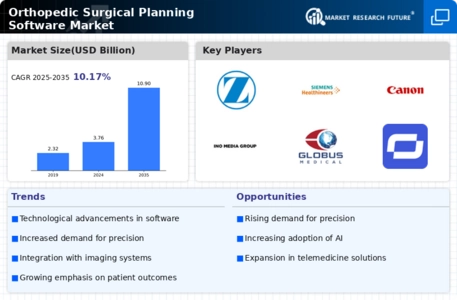The Orthopedic Surgical Planning Software Market is characterized by a dynamic competitive landscape, driven by technological advancements and an increasing demand for precision in surgical procedures. Key players such as Medtronic (US), Stryker (US), and Zimmer Biomet (US) are at the forefront, each adopting distinct strategies to enhance their market positioning. Medtronic (US) focuses on innovation through the integration of AI and machine learning into its surgical planning tools, aiming to improve surgical outcomes and streamline workflows. Stryker (US), on the other hand, emphasizes strategic partnerships and acquisitions to expand its product offerings and enhance its technological capabilities. Zimmer Biomet (US) is actively pursuing regional expansion, particularly in emerging markets, to capitalize on the growing demand for orthopedic solutions. Collectively, these strategies contribute to a competitive environment that is increasingly centered around technological innovation and strategic collaborations.
In terms of business tactics, companies are localizing manufacturing and optimizing supply chains to enhance efficiency and reduce costs. The market structure appears moderately fragmented, with several key players exerting significant influence. This fragmentation allows for a variety of solutions and innovations, fostering a competitive atmosphere where companies must continuously adapt to maintain their market share.
In August 2025, Medtronic (US) announced the launch of its latest AI-driven surgical planning software, which is designed to provide real-time analytics during orthopedic procedures. This strategic move is likely to enhance surgical precision and improve patient outcomes, positioning Medtronic as a leader in the integration of advanced technologies in surgical planning. The introduction of this software reflects a broader trend towards digitalization in the healthcare sector, where data-driven insights are becoming increasingly vital.
In September 2025, Stryker (US) completed the acquisition of a leading software development firm specializing in 3D imaging technologies. This acquisition is expected to bolster Stryker's capabilities in providing comprehensive surgical planning solutions, thereby enhancing its competitive edge. By integrating advanced imaging technologies into its offerings, Stryker aims to improve the accuracy of preoperative assessments and surgical outcomes, aligning with the industry's shift towards more personalized and precise surgical interventions.
In July 2025, Zimmer Biomet (US) launched a new cloud-based platform that facilitates collaborative surgical planning among orthopedic surgeons. This platform allows for real-time sharing of surgical plans and patient data, fostering collaboration and improving decision-making processes. The strategic importance of this initiative lies in its potential to enhance communication among surgical teams, ultimately leading to better patient care and outcomes. As the demand for collaborative approaches in healthcare grows, Zimmer Biomet's platform positions the company favorably in the market.
As of October 2025, current competitive trends in the Orthopedic Surgical Planning Software Market are heavily influenced by digitalization, sustainability, and the integration of artificial intelligence. Strategic alliances are increasingly shaping the landscape, as companies recognize the value of collaboration in driving innovation. Looking ahead, competitive differentiation is likely to evolve from traditional price-based competition to a focus on technological advancements, innovative solutions, and reliable supply chains. This shift underscores the importance of adaptability and forward-thinking strategies in maintaining a competitive edge in the rapidly evolving market.

















Leave a Comment